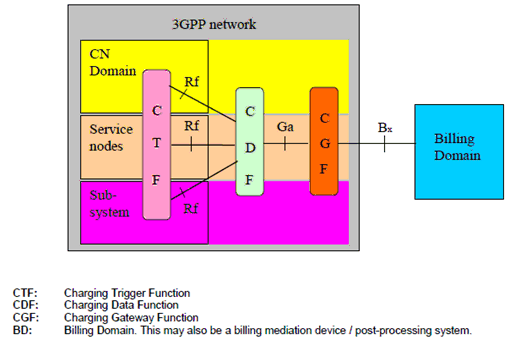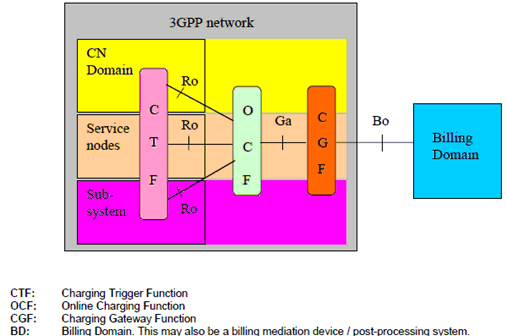Content for TS 32.299 Word version: 18.0.0
1 Scope
2 References
3 Definitions, symbols and abbreviations
3.1 Definitions
3.2 Symbols
3.3 Abbreviations
4 Architecture considerations
4.1 High level architecture
...
...
1 Scope p. 14
The present document is part of a series of Technical Specifications (TSs) that specify charging functionality and charging management in GSM/UMTS networks. The GSM/UMTS core network-charging architecture and principles are specified in TS 32.240, which provides an umbrella for other charging management documents that specify.
- The content of the CDRs' per domain and subsystem (offline charging);
- The content of real-time charging messages per domain / subsystem (online charging);
- The functionality of online and offline charging for those domains and subsystems;
- The interfaces that are used in the charging framework to transfer the charging information (i.e. CDRs or charging events).
2 References p. 15
The following documents contain provisions which, through reference in this text, constitute provisions of the present document.
- References are either specific (identified by date of publication, edition number, version number, etc.) or non-specific.
- For a specific reference, subsequent revisions do not apply.
- For a non-specific reference, the latest version applies. In the case of a reference to a 3GPP document (including a GSM document), a non-specific reference implicitly refers to the latest version of that document in the same Release as the present document.
[1]
TS 32.240: "Telecommunication management; Charging management; Charging architecture and principles ".
[2] - [10] Void.
[11]
TS 32.251: "Telecommunication management; Charging management; Packet Switched (PS) domain charging".
[12] Void.
[13]
TS 32.253: "Telecommunication management; Charging management; Control Plane (CP) data transfer domain charging".
[14] - [99] Void.
[100]
TR 21.905: "Vocabulary for 3GPP Specifications".
[101]
TS 22.115: "Service aspects; Charging and billing".
[102] - [199] Void.
[200]
TS 23.207: "End to end quality of service concept and architecture".
[201]
TS 23.228: "IP Multimedia Subsystem (IMS); Stage 2".
[202]
TS 24.229: "IP Multimedia Call Control Protocol based on SIP and SDP; Stage 3".
[203]
TS 29.207: "Policy control over Go interface".
[204]
TS 29.229: "Cx and Dx Interfaces based on the Diameter protocol; Protocol Details".
[205] Void.
[206]
TS 29.230: "3GPP specific codes and identifiers".
[207]
TS 29.061: "Interworking between the Public Land Mobile Network (PLMN) supporting packet based services and Packet Data Networks (PDN)".
[208]
TS 23.140: " Multimedia Messaging Service (MMS); Functional description; Stage 2".
[209]
OMA "Multimedia Messaging Service; Encapsulation Protocol":
[210]
OMNA WSP Content Type Numbers: http://www.openmobilealliance.org/tech/omna/omna-wsp-content-type.aspx
[211]
OMA-CP-POC: "OMA PoC Control Plane".
[212] Void.
[213]
3GPP TS 29.140: "MM10 interface based on Diameter protocol; Stage 3".
[214]
TS 29.214: "Policy and Charging Control over Rx reference point; Stage 3".
[215]
TS 29.212: "Policy and Charging Control (PCC); Reference points".
[216]
TS 23.040: "Technical realization of Short Message Service (SMS)".
[217]
TS 22.142: "Value Added Services (VAS) for Short Message Service (SMS) requirements".
[218]
TS 23.203: "Policy and Charging control architecture".
[219]
TS 29.272: " Mobility Management Entity (MME) and Serving GPRS Support Node (SGSN) related interfaces based on Diameter protocol".
[220]
TS 24.605: "Conference (CONF) using IP Multimedia (IM) Core Network (CN) subsystem; Protocol specification".
[221]
TS 29.329: "Sh Interface based on the Diameter protocol;Protocol details".
[222]
TS 29.658: "SIP Transfer of IP Multimedia Service Tariff Information".
[223]
OMA-DDS-Charging_Data: "Charging Data".
[224]
TS 23.003: "Numbering, Addressing and Identification".
[225]
TS 29.060: "General Packet Radio Service (GPRS); GPRS Tunnelling Protocol (GTP) across the Gn and Gp interface".
[226]
TS 29.274: "Evolved GPRS Tunnelling Protocol for Control Plane (GTPv2-C); Stage 3".
[227]
TS 23.032: "Universal Geographical Area Description (GAD)".
[228]
TS 23.167: "IP Multimedia Subsystem (IMS) emergency sessions".
[229]
TS 29.173: "Location Services (LCS);Diameter-based SLh interface for Control Plane LCS".
[230]
TS 29.272: "Evolved Packet System (EPS);Mobility Management Entity (MME) and Serving GPRS Support Node (SGSN) related interfaces based on Diameter protocol".
[231]
TS 29.337: "Diameter-based T4 interface for communications with packet data networks and applications ".
[232]
TS 29.002: "Mobile Application Part (MAP) specification".
[233]
TS 29.078: "Customised Applications for Mobile network Enhanced Logic (CAMEL); CAMEL Application Part (CAP) specification".
[234]
TS 29.163: "Interworking between the IP Multimedia (IM) Core Network (CN) subsystem and Circuit Switched (CS) networks".
[235]
TS 23.303: "Proximity-based services (ProSe)".
[236]
TS 24.334: "Proximity-services (ProSe) User Equipment (UE) to ProSe function protocol aspects".
[237]
TS 29.273: "Evolved Packet System (EPS); 3GPP EPS AAA Interfaces".
[238]
TS 29.343: "Proximity-services (ProSe) function to ProSe application server aspects (PC2)".
[239]
TS 29.345: "Inter-Proximity-services (ProSe) Function signalling aspects".
[240] Void.
[241]
TS 36.331: "Evolved Universal Terrestrial Radio Access (E-UTRA); Radio Resource Control (RRC); Protocol specification".
[242] Void.
[243]
TS 23.682: "Architecture enhancements to facilitate communications with packet data networks and applications".
[244]
TS 29.128: "Mobility Management Entity (MME) and Serving GPRS Support Node (SGSN) interfaces for interworking with packet data networks and applications".
[245]
TS 29.336: "Home Subscriber Server (HSS) diameter interfaces for interworking with packet data networks and applications".
[246]
TS 33.210: "3G security; Network Domain Security (NDS); IP network layer security ".
[247] - [299] Void.
[300]
ETSI TS 283 034 v2.2.0: "Telecommunications and Internet converged Services and Protocols for Advanced Networking (TISPAN); Network Attachment Sub-System (NASS); e4 interface based on the DIAMETER protocol".
[301]
oneM2M TS-0004: "Service Layer Core Protocol Specification".
[302] - [400] Void.
[401]
RFC 6733 (2012): "Diameter Base Protocol".
[402]
RFC 4006 (2005): "Diameter Credit-Control Application".
[403] Void.
[404]
RFC 7315 (2014): "Private Extensions to the Session Initiation Protocol (SIP) for the 3rd Generation Partnership Projects (3GPP)".
[405]
RFC 3261 (2002): "SIP: Session Initiation Protocol".
[406]
RFC 4566 (2006): "SDP: Session Description Protocol".
[407]
RFC 4005 (2005): "Diameter Network Access Server Application".
[408]
RFC 3264 (2002): "An Offer/Answer Model with the Session Description Protocol (SDP) ".
[409]
IEEE 802.11-2012: "IEEE Standard for Information technology - Telecommunications and information exchange between systems - Local and metropolitan area networks - Specific requirements - Part 11: Wireless LAN Medium Access Control (MAC) and Physical Layer (PHY) Specifications".
[410]
RFC 3066 (2001): "Tags for the Identification of Languages".
[411]
RFC 7683 (2015):"Diameter Overload Indication Conveyance".
3 Definitions, symbols and abbreviations p. 17
3.1 Definitions p. 17
For the purposes of the present document, the terms and definitions given in TR 21.905 and the following apply. A term defined in the present document takes precedence over the definition of the same term, if any, in TR 21.905.
middle tier TS:
term used for the 3GPP charging TSs that specify the domain / subsystem / service specific, online and offline, charging functionality. These are all the TSs in the numbering range from TS 32.250 to TS 32.27x, e.g. TS 32.250 for the CS domain, or TS 32.270 for the MMS service. Currently, there is only one "tier 1" TS in 3GPP, which is the TS 32.240 that specifies the charging architecture and principles. Finally, there are a number of top tier TSs in the 32.29x numbering range ([50] ff) that specify common charging aspects such as parameter definitions, encoding rules, the common billing domain interface or common charging applications.
offline charging:
charging mechanism where charging information does not affect, in real-time, the service rendered
online charging:
charging mechanism where charging information can affect, in real-time, the service rendered and therefore a direct interaction of the charging mechanism with session/service control is required
3.2 Symbols p. 18
For the purposes of the present document, the following symbols apply:
Rf
Offline Charging Reference Point between a 3G network element and the CDF.
Ro
Online Charging Reference Point between a 3G network element and the OCS.
3.3 Abbreviations p. 18
For the purposes of the present document, the following abbreviations apply:
5GS
5G System
5GC
5G Core
ACA
ACcounting-Answer
ACR
ACcounting-Request
ADC
Application Detection and Control
AoC
Advice of Charge
AS
Application Server
ASA
Abort-Session-Answer
ASR
Abort-Session- Request
AVP
Attribute Value Pair
CCA
Credit-Control-Answer
CCR
Credit-Control-Request
CDF
Charging Data Function
CDR
Charging Data Record
CEA
Capabilities-Exchange-Answer
CER
Capabilities-Exchange-Request
CGI
Cell Global Identification
CI
Cost-Information
CIoT
Cellular Internet of Things
CP
Control Plane
CSG
Closed Subscriber Group
CSG ID
Closed Subscriber Group Identity
DBPA
Diameter Base Protocol Accounting
DCD
Dynamic Content Delivery
DPA
Disconnect-Peer-Answer
DPR
Disconnect-Peer-Request
DRM
Digital Rights Management
DWA
Device-Watchdog-Answer
DWR
Device-Watchdog-Request
ECGI
E-UTRAN Cell Global Identifier
ECUR
Event Charging with Unit Reservation
FQDN
Fully Qualified Domain Name
FUI
Final-Unit-Indication
HSGW
HRPD Serving GateWay
GSU
Granted-Service-Unit
IEC
Immediate Event Charging
IM
Instant Messaging
IMS
IP Multimedia Subsystem
IMS-AGW
IMS Access Media Gateway
IWK-SCEF
Interworking SCEF
MSCC
Multiple Services Credit-Control
NetLoc
Network provided Location information
NIDD
Non-IP Data Delivery
NNI
Network to Network Interface
NR
New Radio
OCS
Online Charging System
PFDF
Packet Flow Description Function
ProSe
Proximity-based Services
RAA
Re-Auth-Answer
RAI
Routeing Area Identity
RAR
Re-Auth-Request
RAVEL
Roaming Architecture for VoicE over IMS with Local breakout
SAI
Service Area Identifier
SCCP
Signalling Connection Control Part
SCEF
Service Capability Exposure Function
SCS
Services Capability Server
SDP
Session Description Protocol
RCAF
RAN Congestion Awareness Function
TAI
Tracking Area Identity
TDF
Traffic Detection Function
TLTRI
T8 Long Term Transaction Reference ID
TrGW
Transition GateWay
TWAG
Trusted WLAN Access Gateway
TWAN
Trusted WLAN Access Network
UWAN
Untrusted Wireless Access Network
VCS
Voice Call Service
4 Architecture considerations p. 20
4.1 High level architecture p. 20
4.1.0 General |R12| p. 20
The Rf and the Ro are reference points from the Charging Trigger Function (CTF) to the Charging Data Function (CDF) and the Online Charging Function (OCF) respectively, and are intended for the transport of charging events. Rf is used for offline charging whereas Ro is used for online charging.
Figure 4.1.0.1 and Figure 4.1.0.2 depict the position of the Rf and Ro reference points within the overall 3GPP online and offline charging architecture.


Different mappings of the ubiquitous offline charging functions, CTF, CDF and CGF, onto physical implementations are possible. Further details of the configuration refer toTS 32.240. Details of the implementation options per domain / subsystem / service (usually a subset of the overall possible variants described above) are specified in the respective middle tier TSs.
4.1.1 Charging related transfer requirements p. 21
Each CTF would have CDF and OCF address list to which it can send its charging events and/or charging requests.
The list is organized in address priority order. If the primary charging function is not available (e.g. out of service) then the CTF shall send the charging information to the secondary charging function and so on.
Within the scope of this release, each Network Element that generates charging information sends the information only to the charging entities of the same PLMN, and not to charging entities in other PLMNs.
To implement roaming unbundling for EU roaming regulation III, an architectural solution known as the Single IMSI architecture has been defined. In this architecture a specific Service-NE (known as a Proxy Function) uses the Ro reference point for sending charging information to an OCF in another network. The details of this architecture are defined in Annex B of TS 32.240.
To implement PS domain online charging for roaming context, PCEF in the VPLMN uses the Gy reference point, and TDF in the VPLMN uses the Gyn reference point, both based on Ro interface and specified in TS 32.251, for sending charging information to an OCS in the HPLMN. A simplified profile is provided in Annex E of TS 32.251 for deployment purposes.
Each CDF in the PLMN may know of other CDFs' network addresses (e.g., for redundancy reasons, to be able to recommend another CDF address with the Redirection Request message). This is achieved by OAM&P configuration facilities that enables each CDF to have a configurable list of peer CDF addresses.